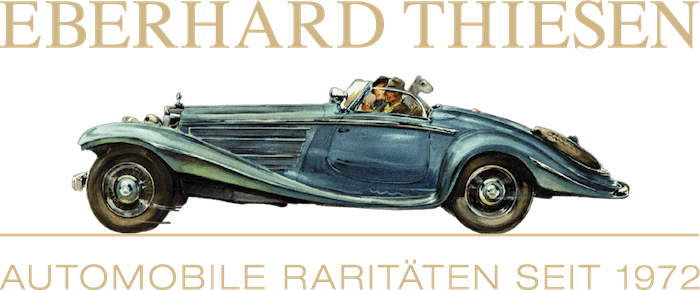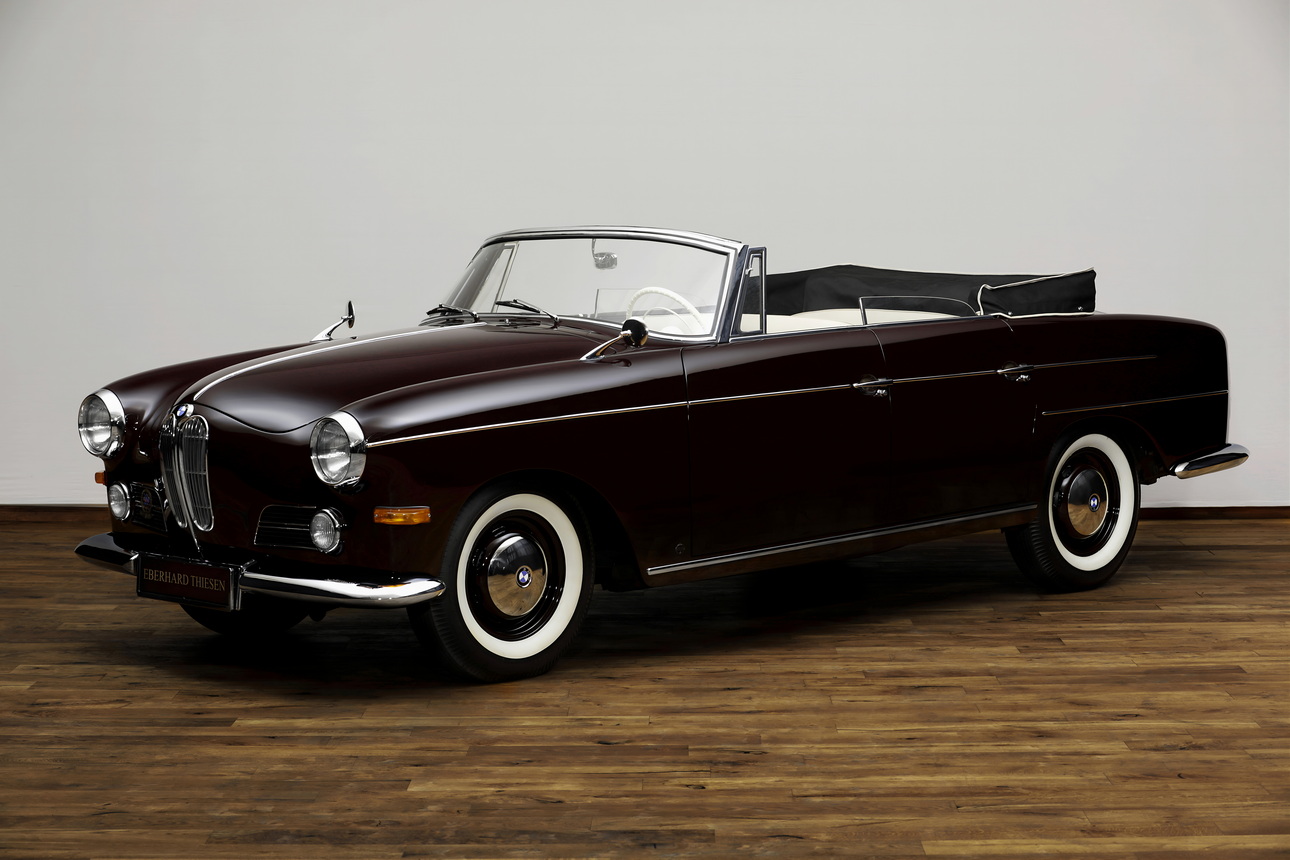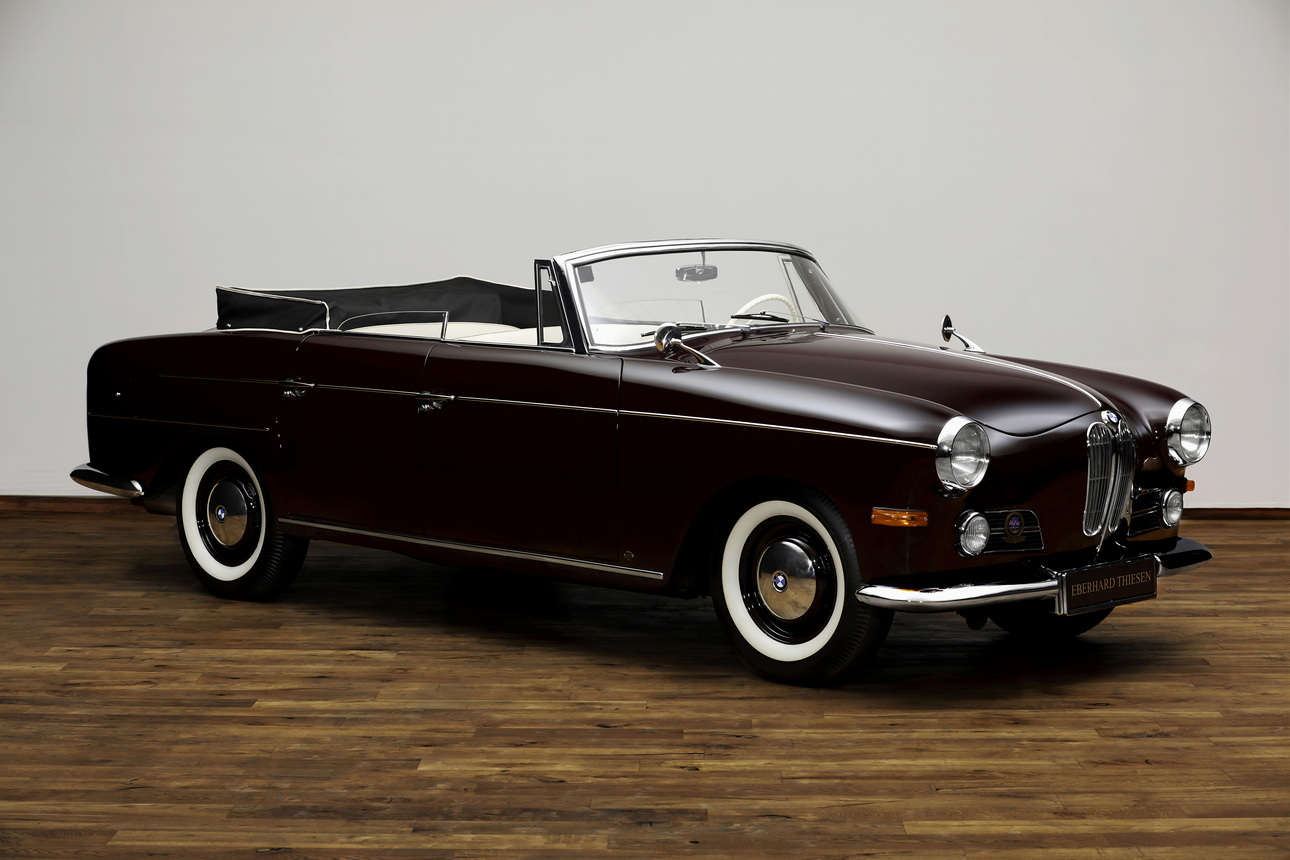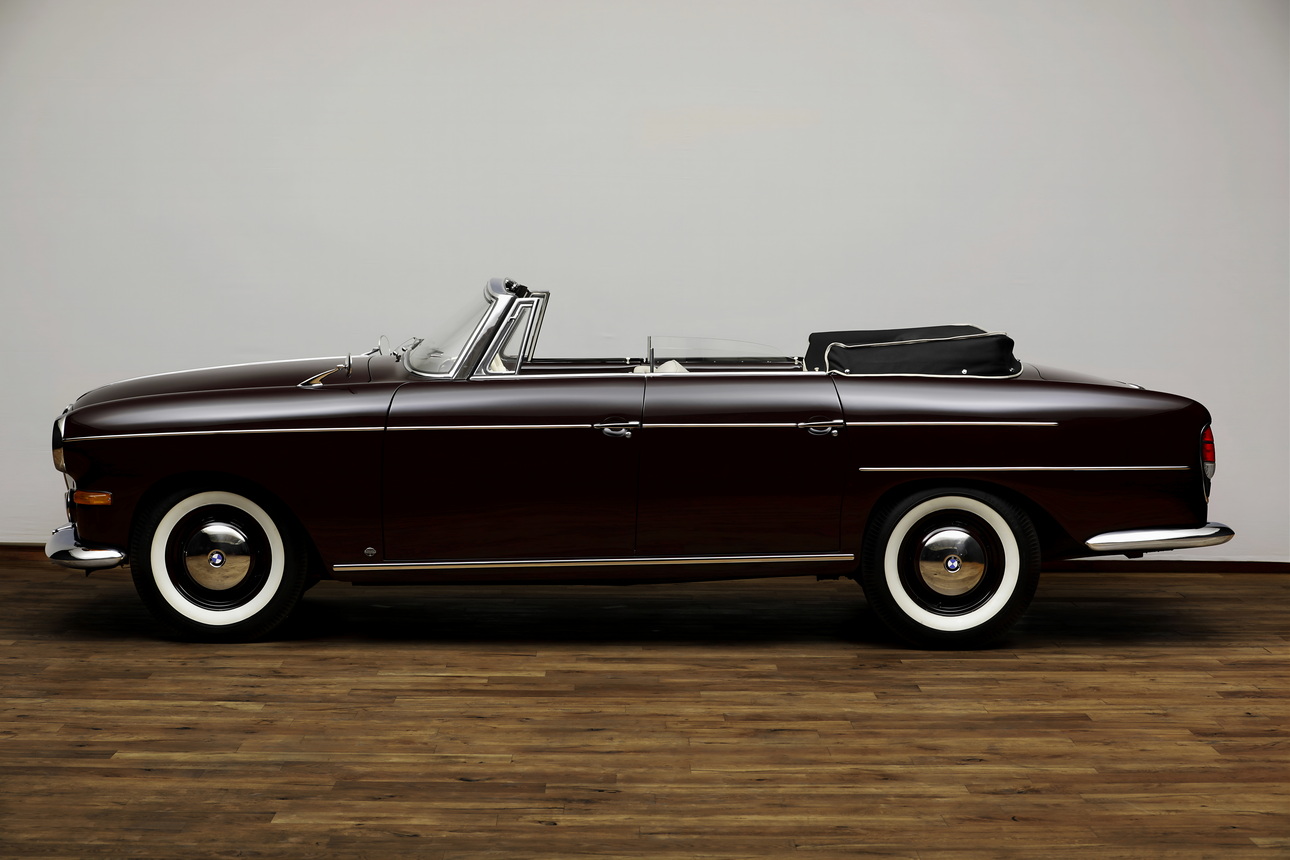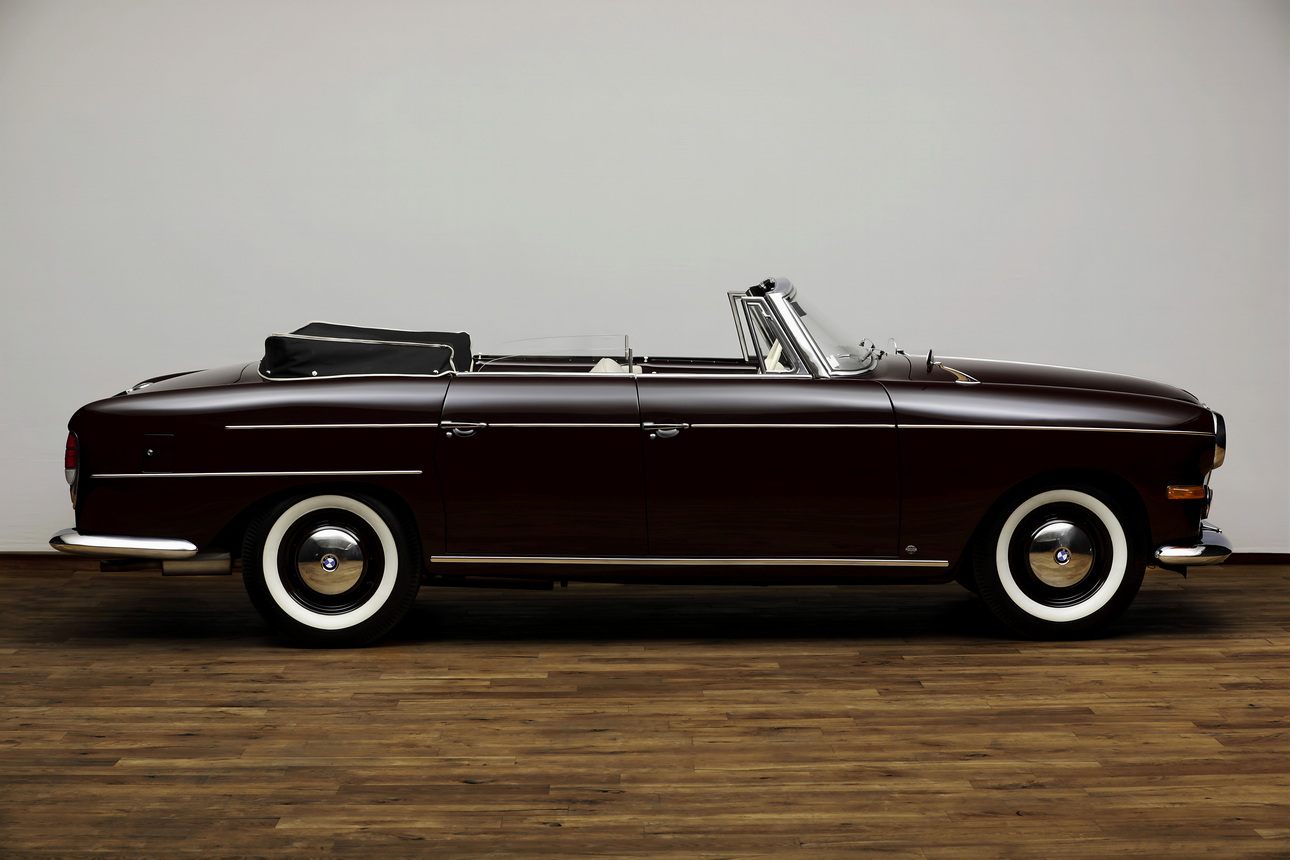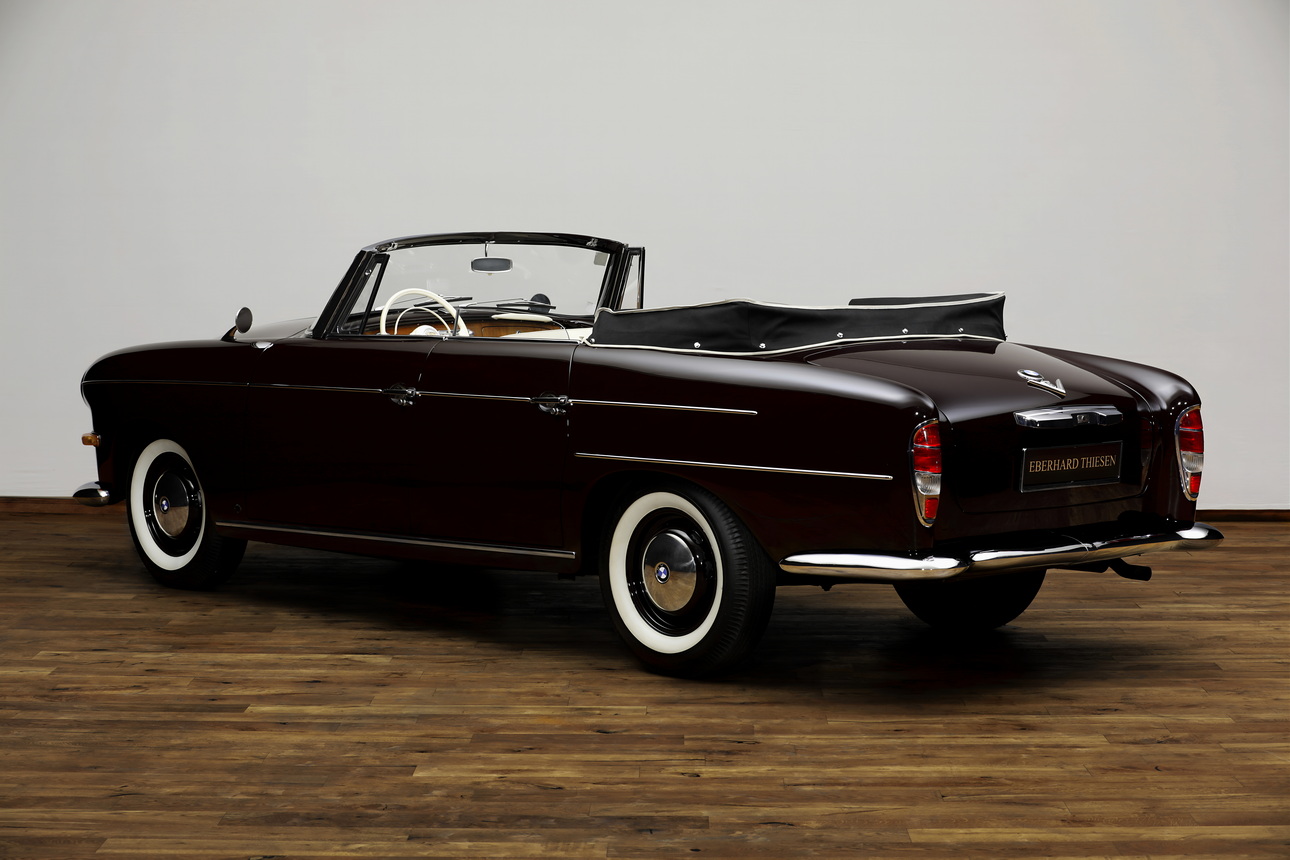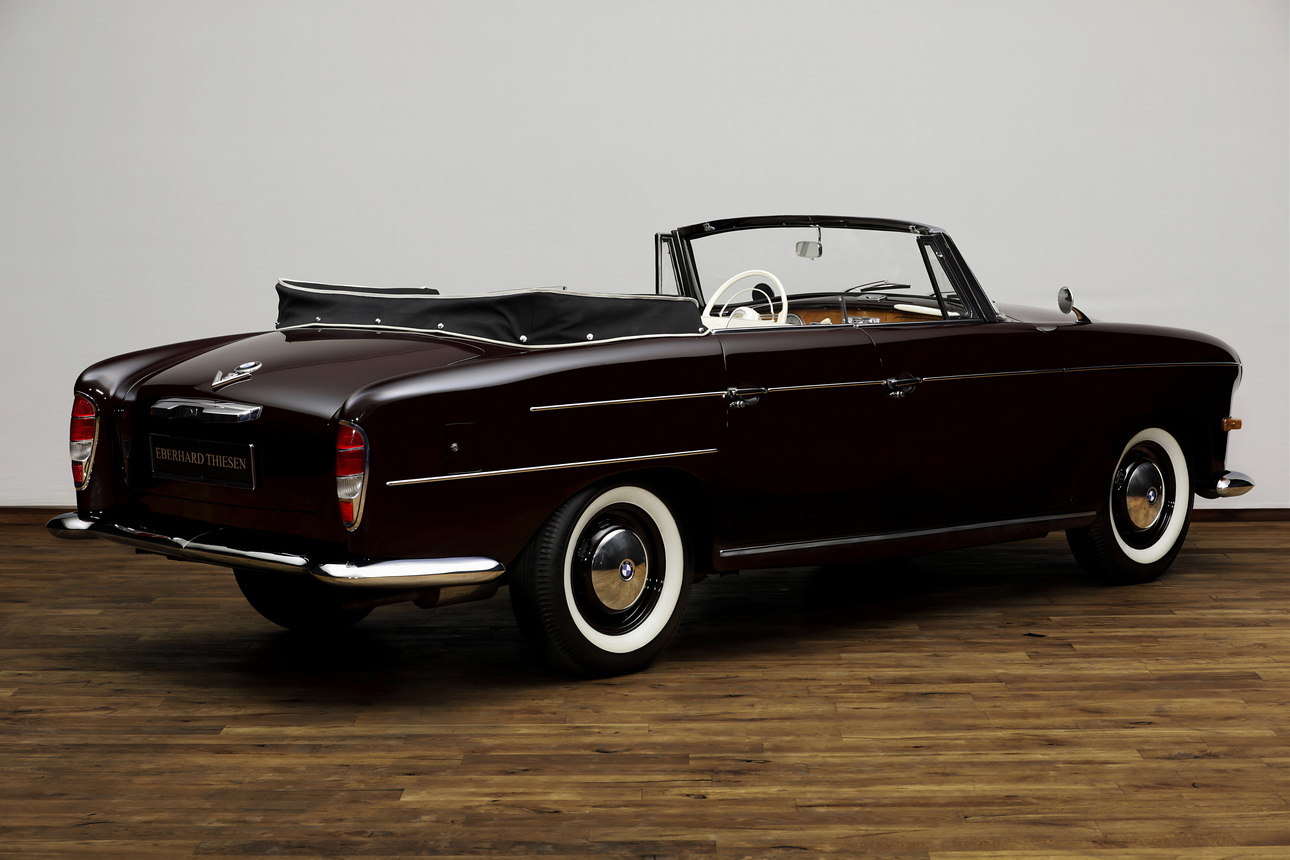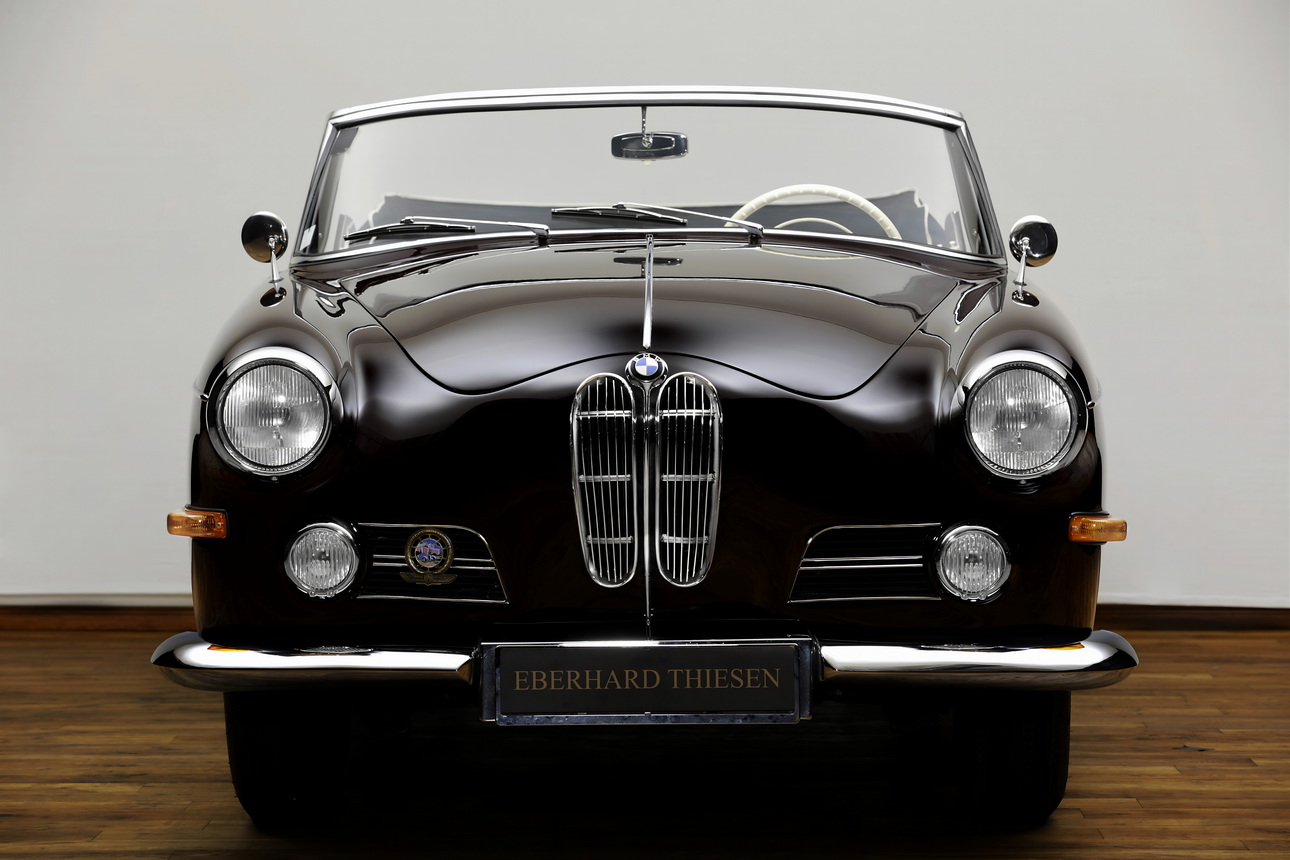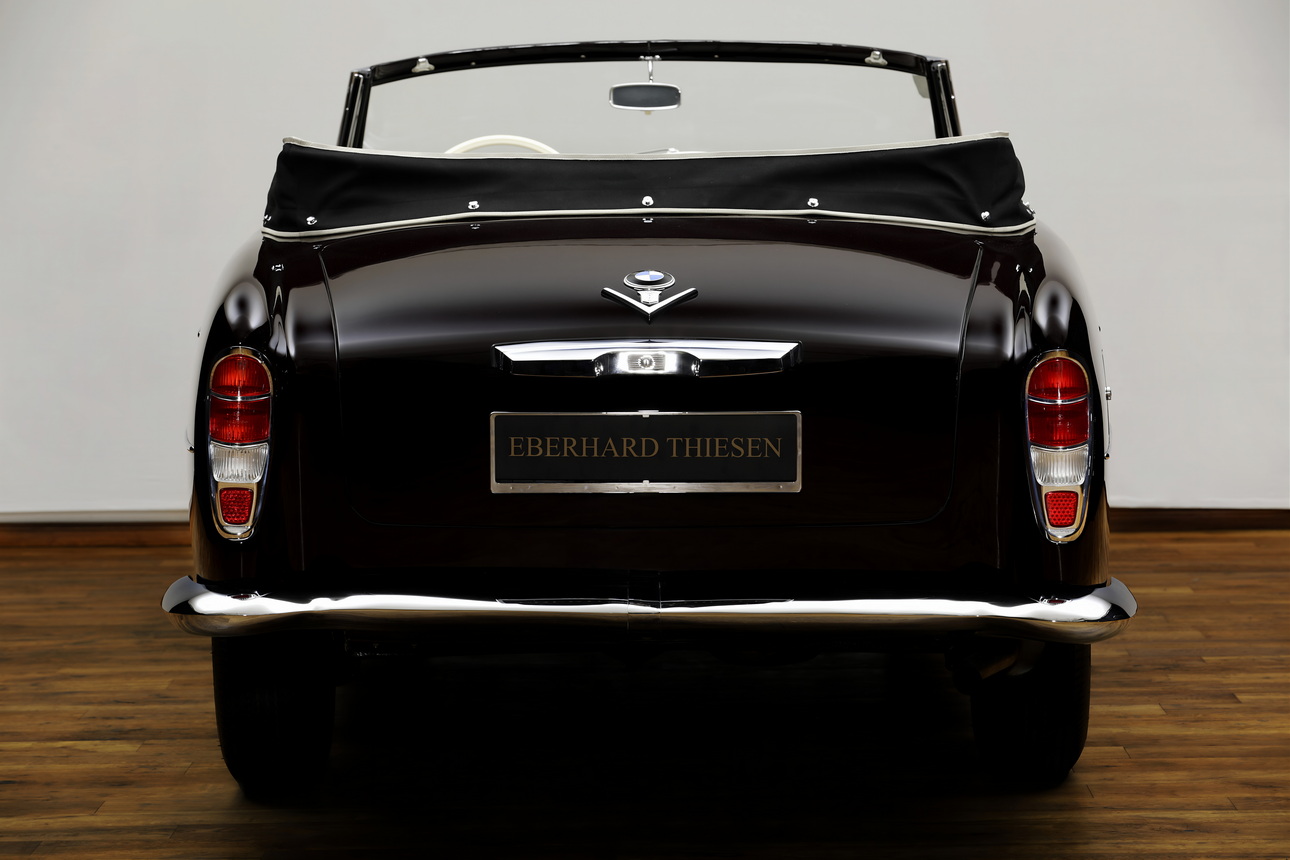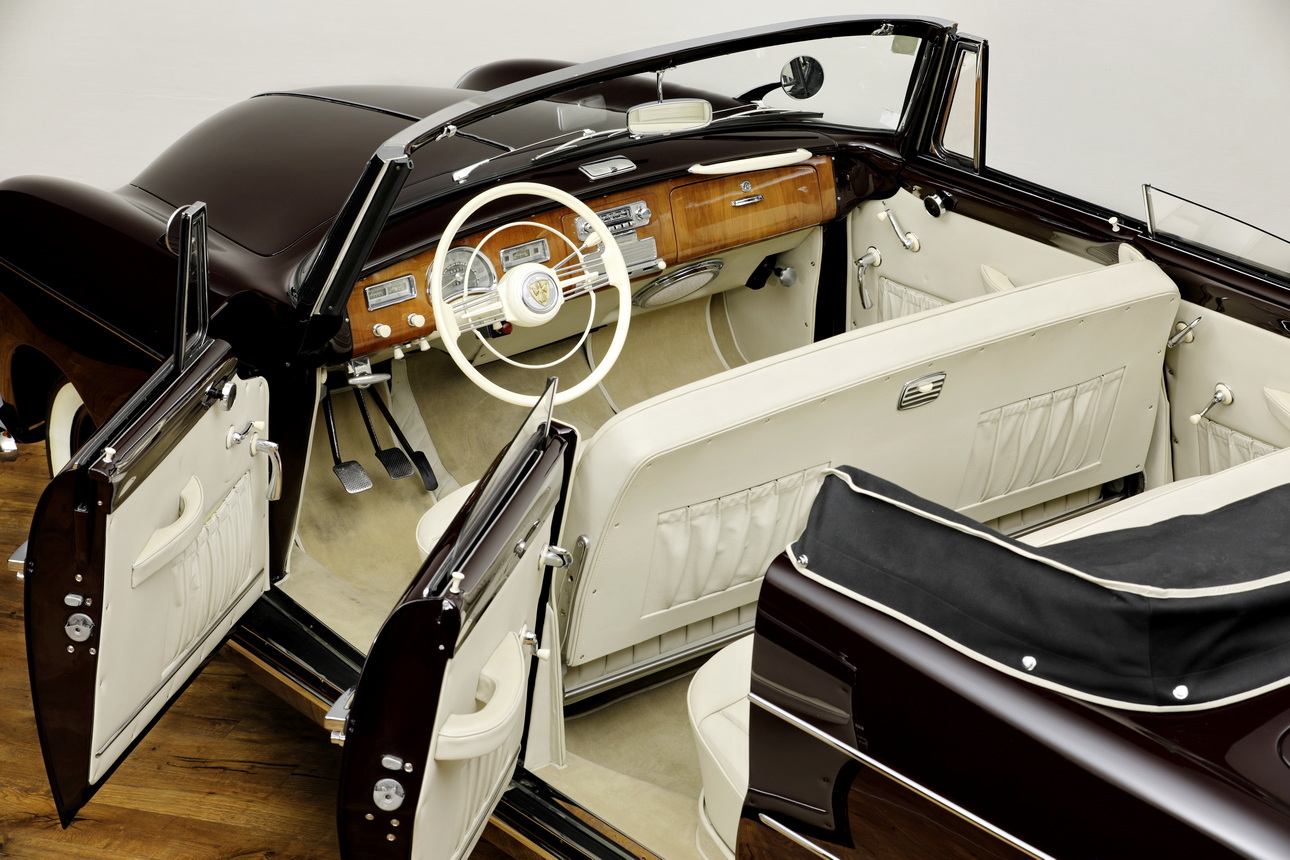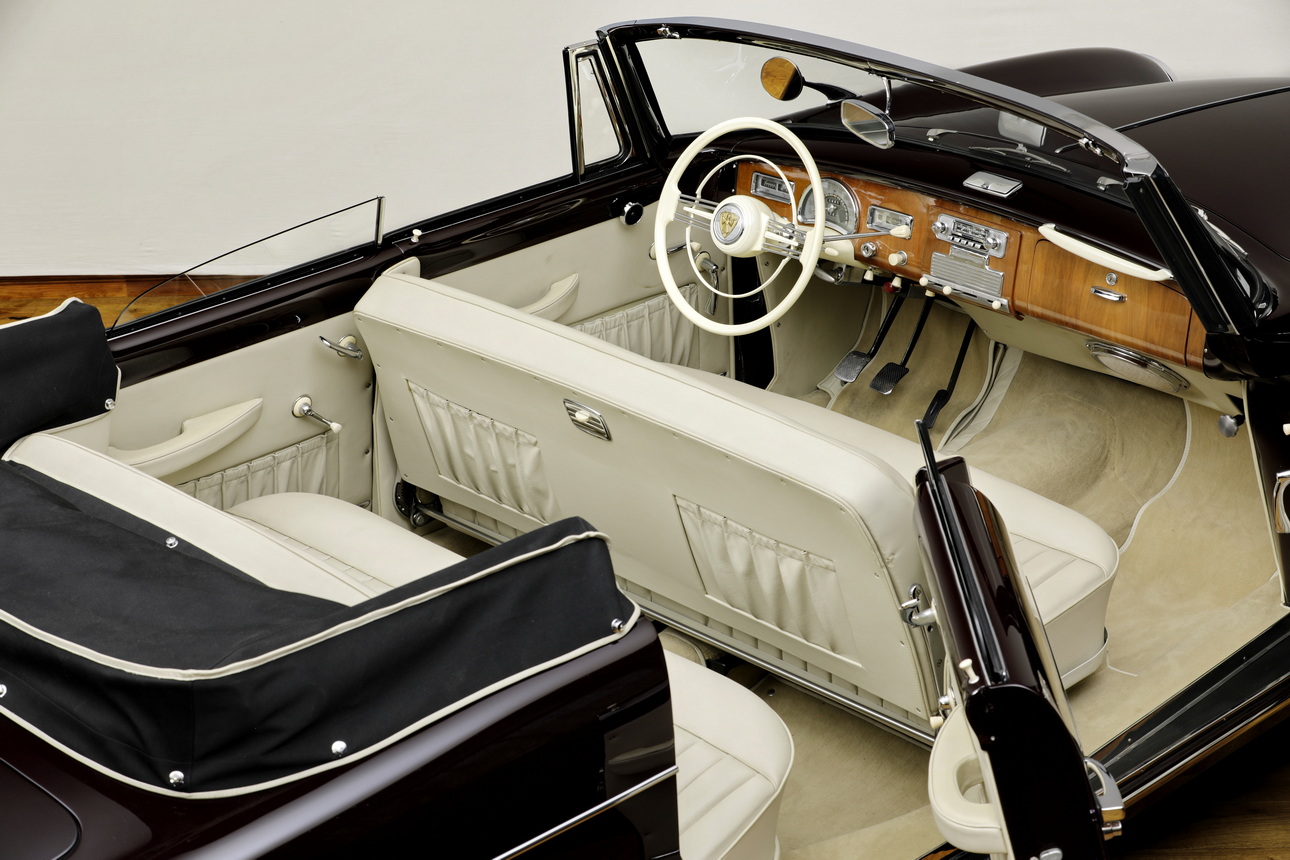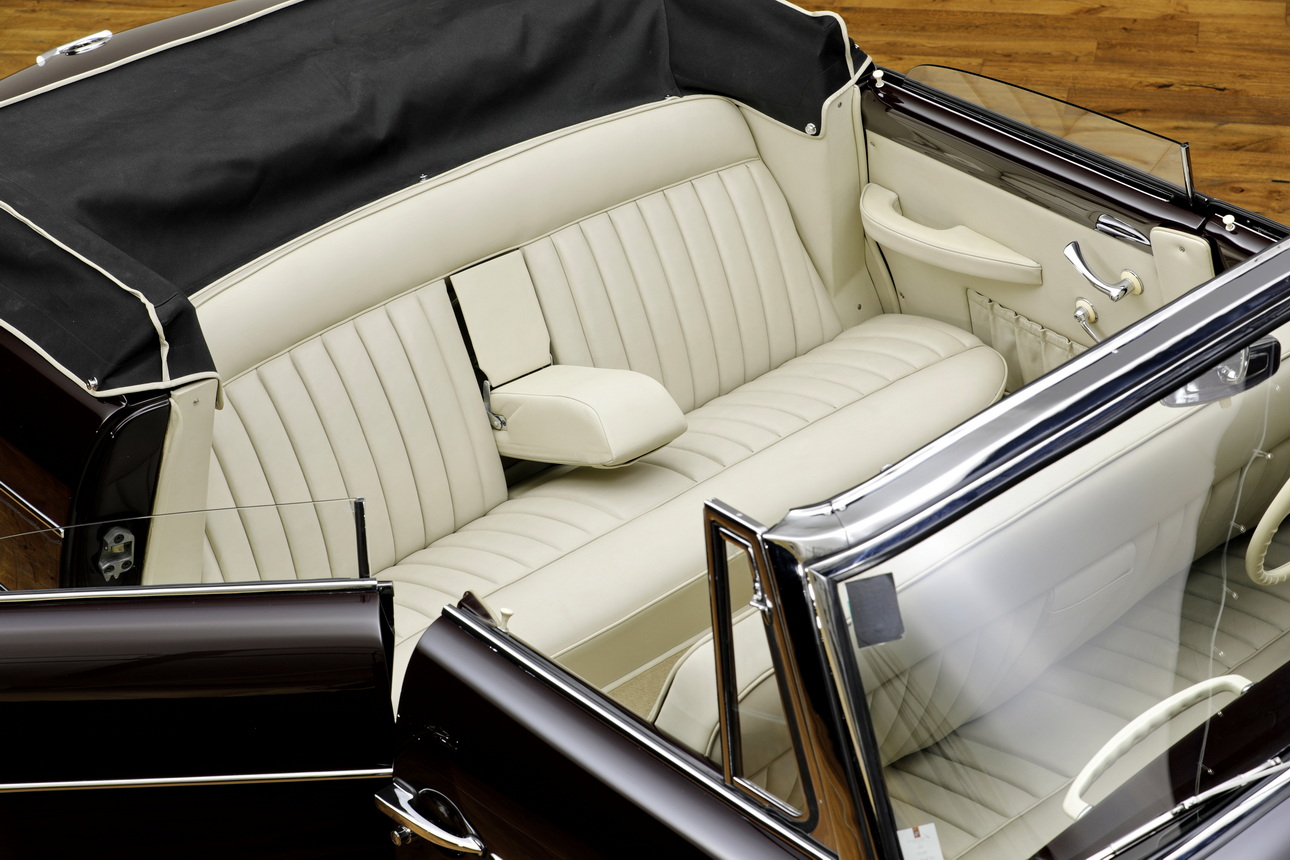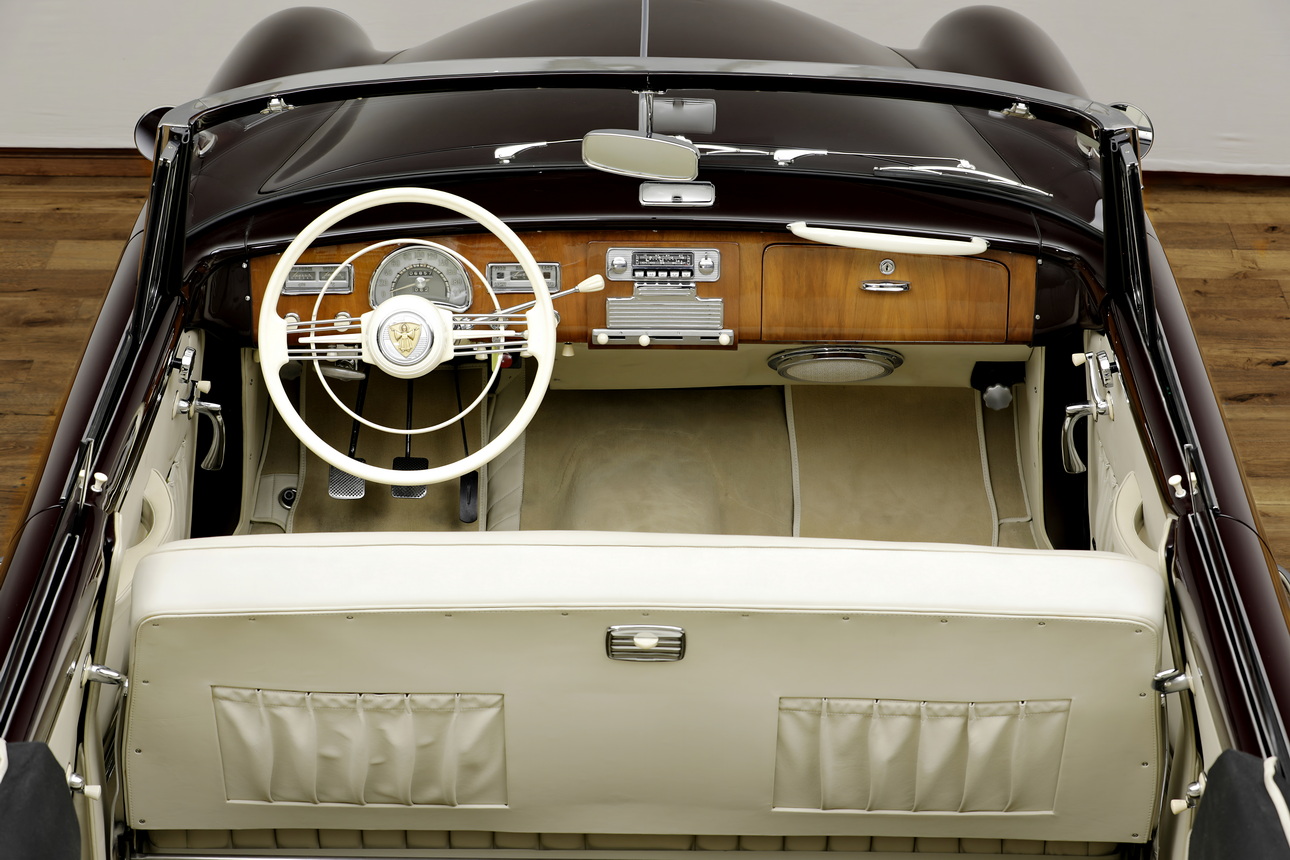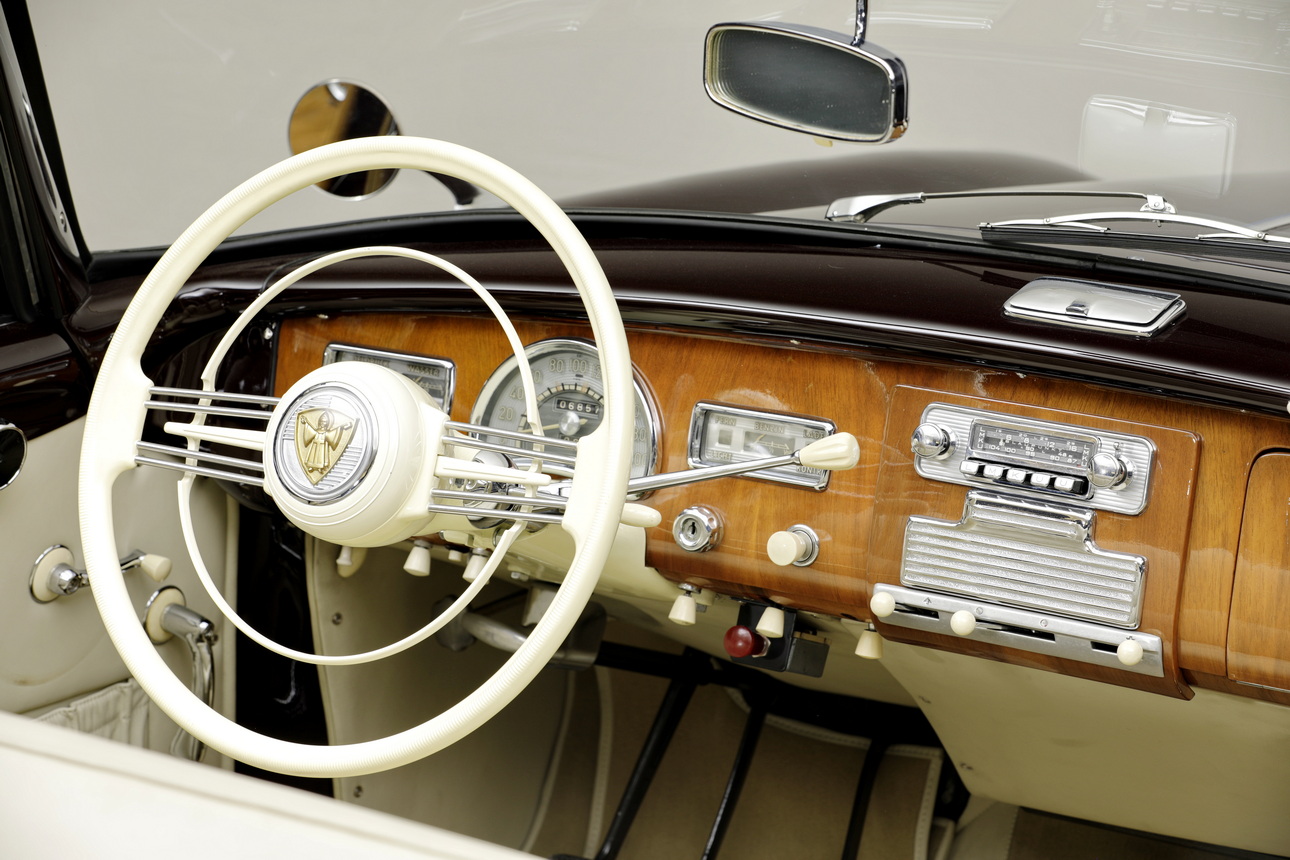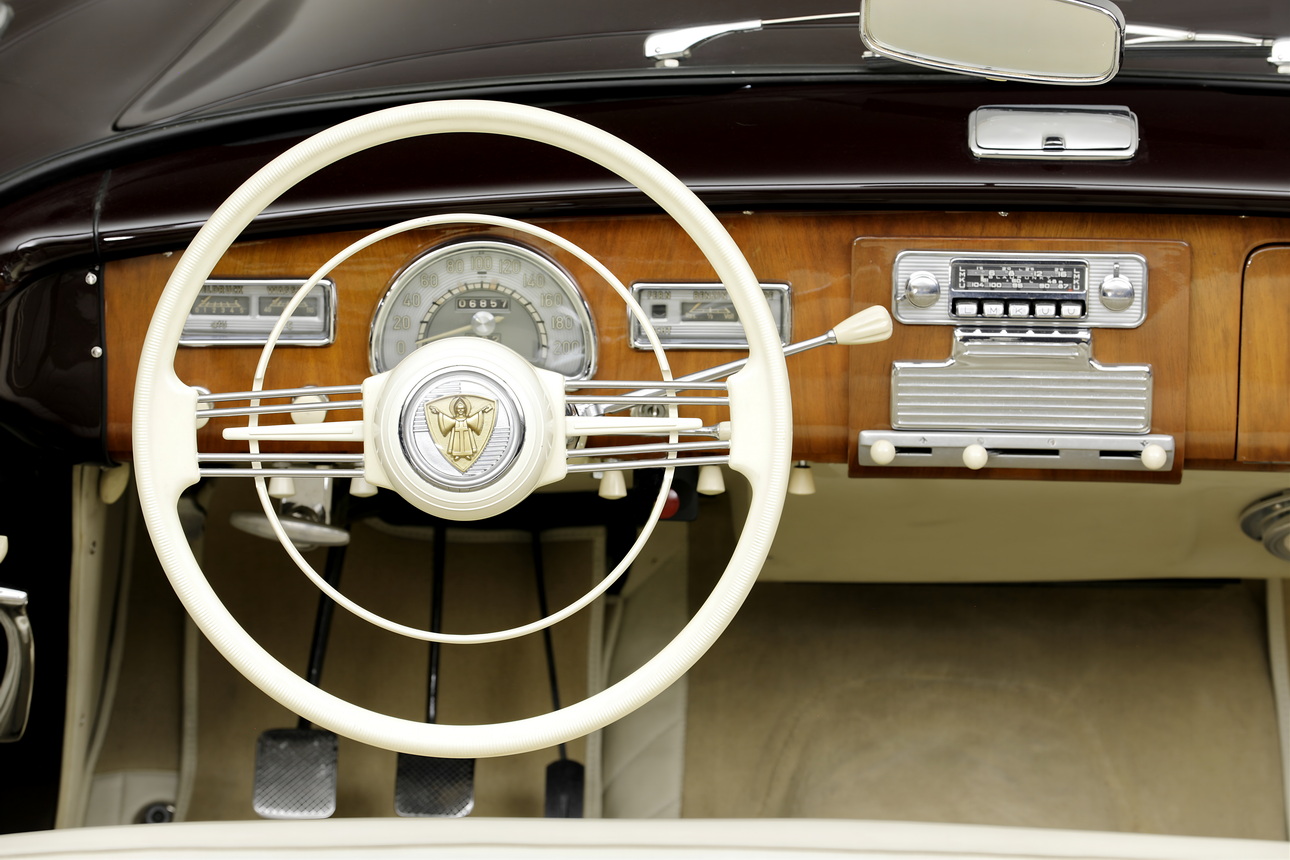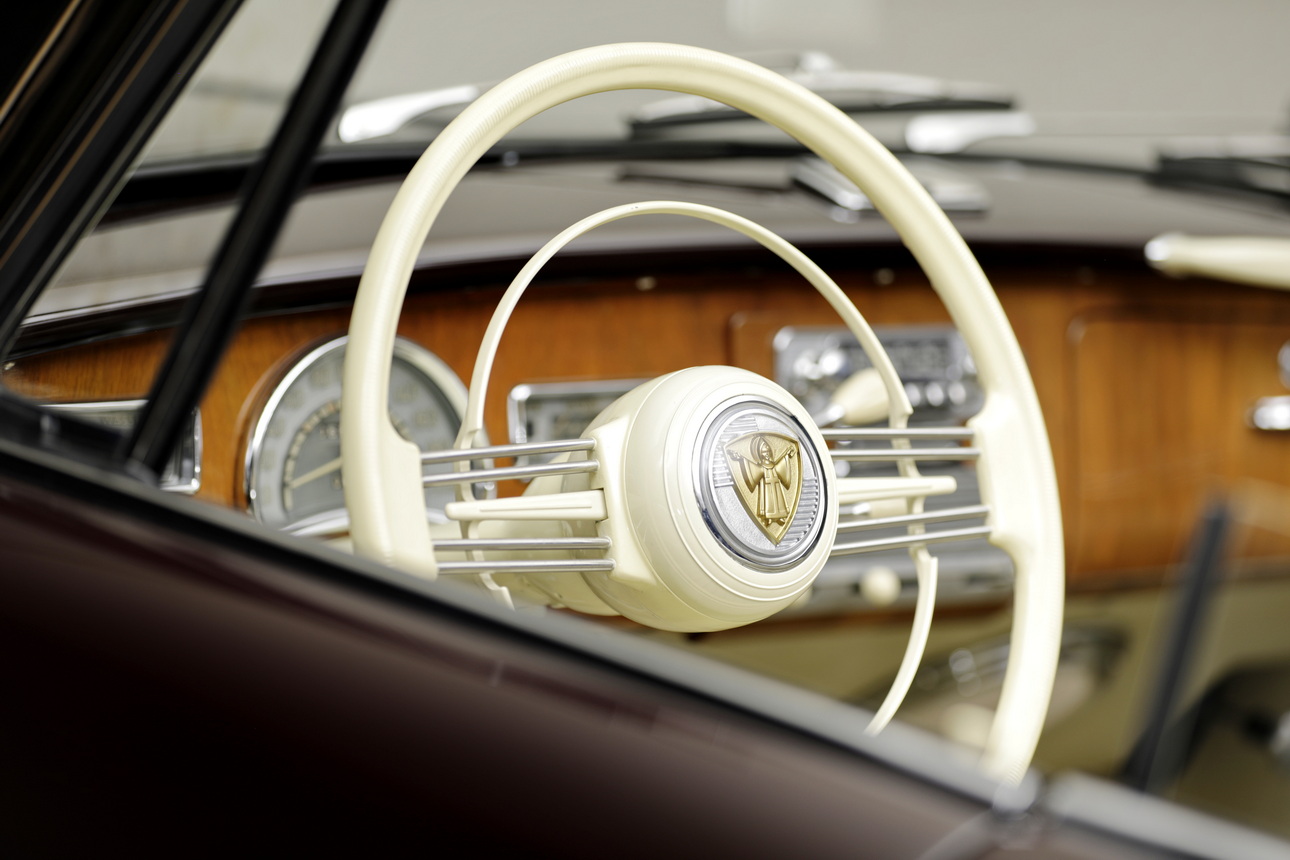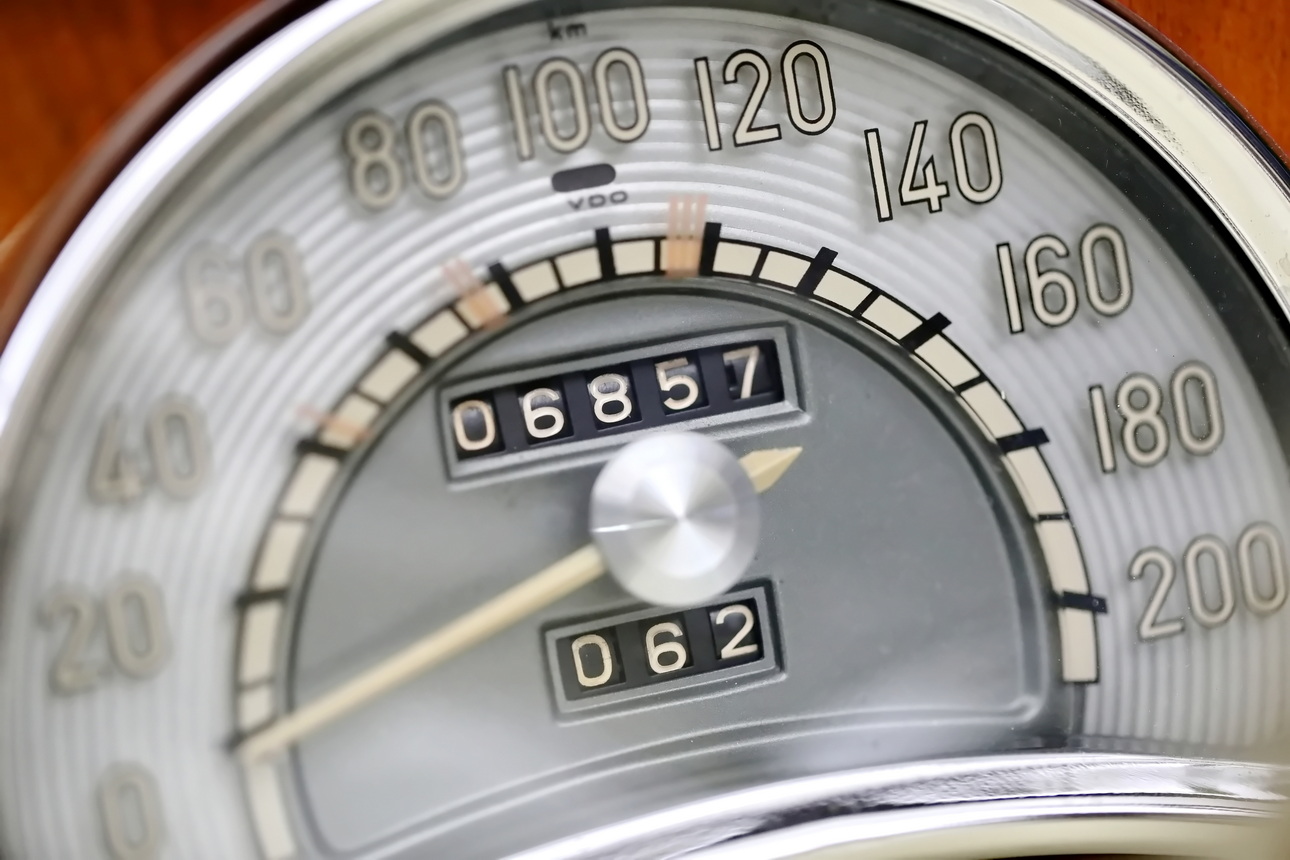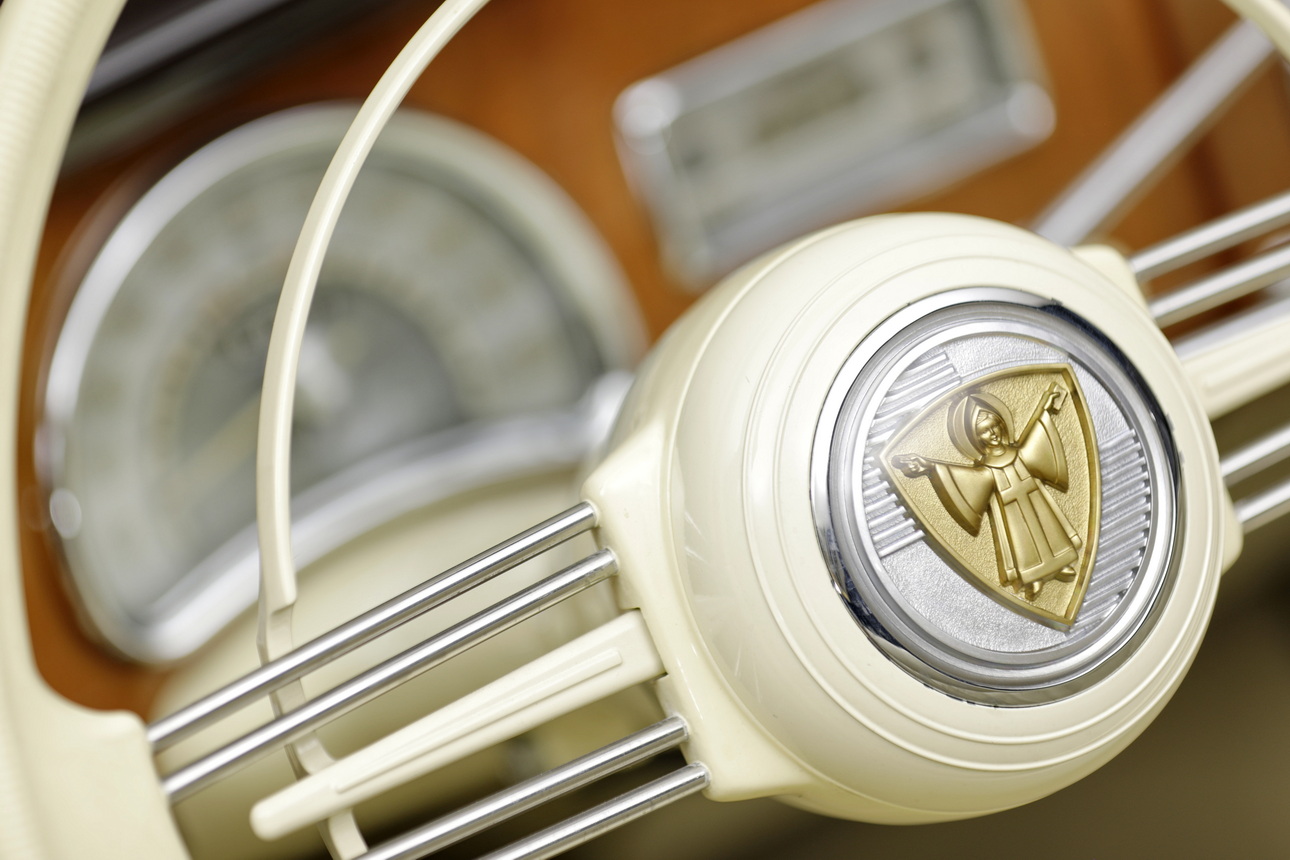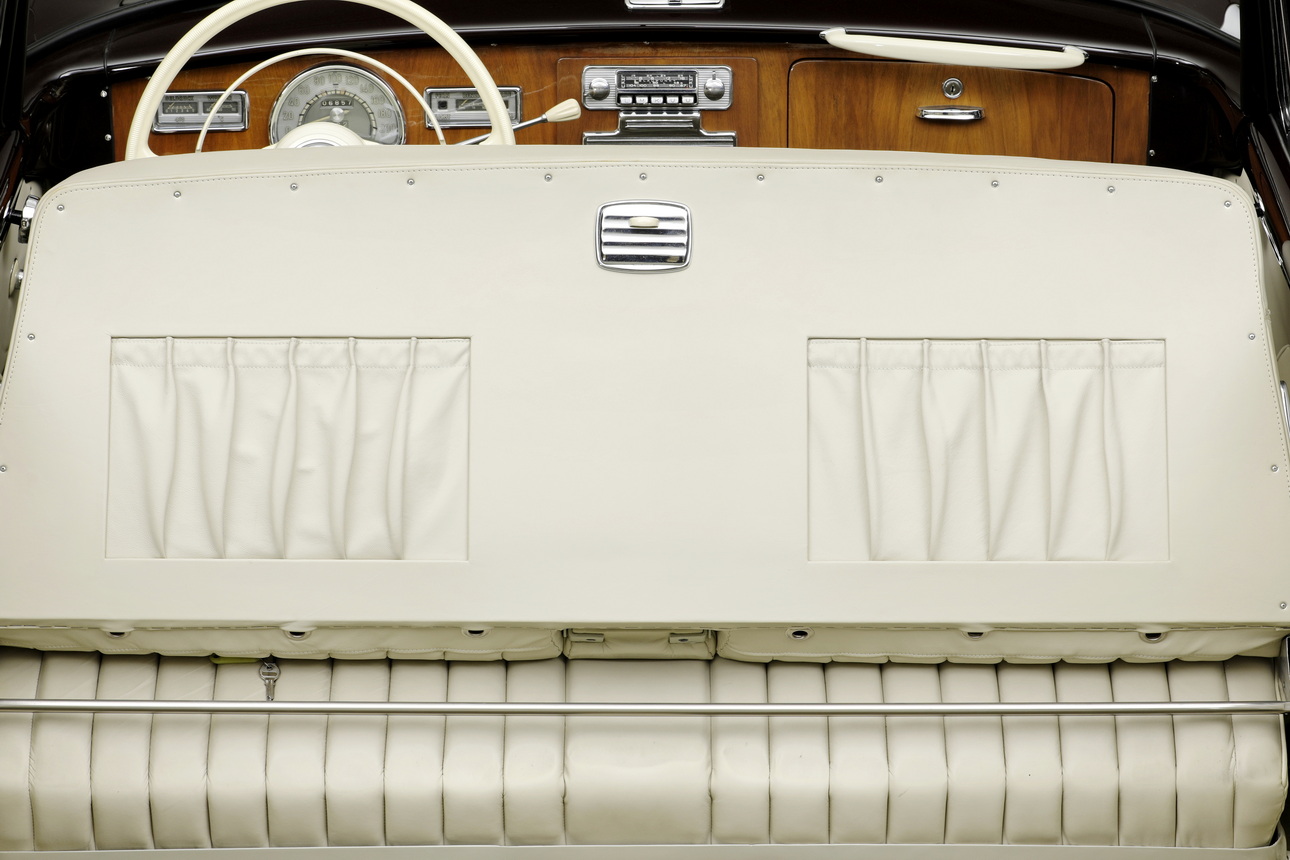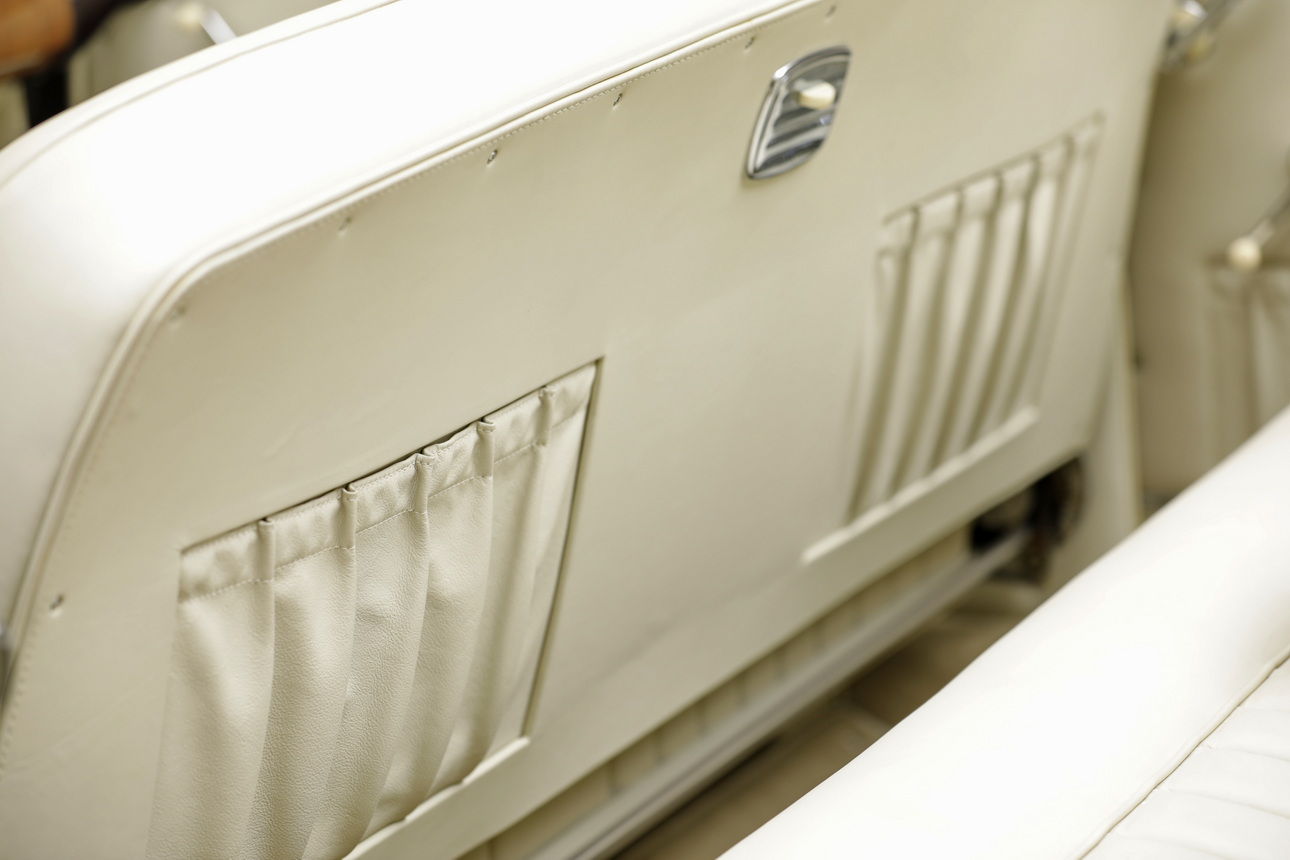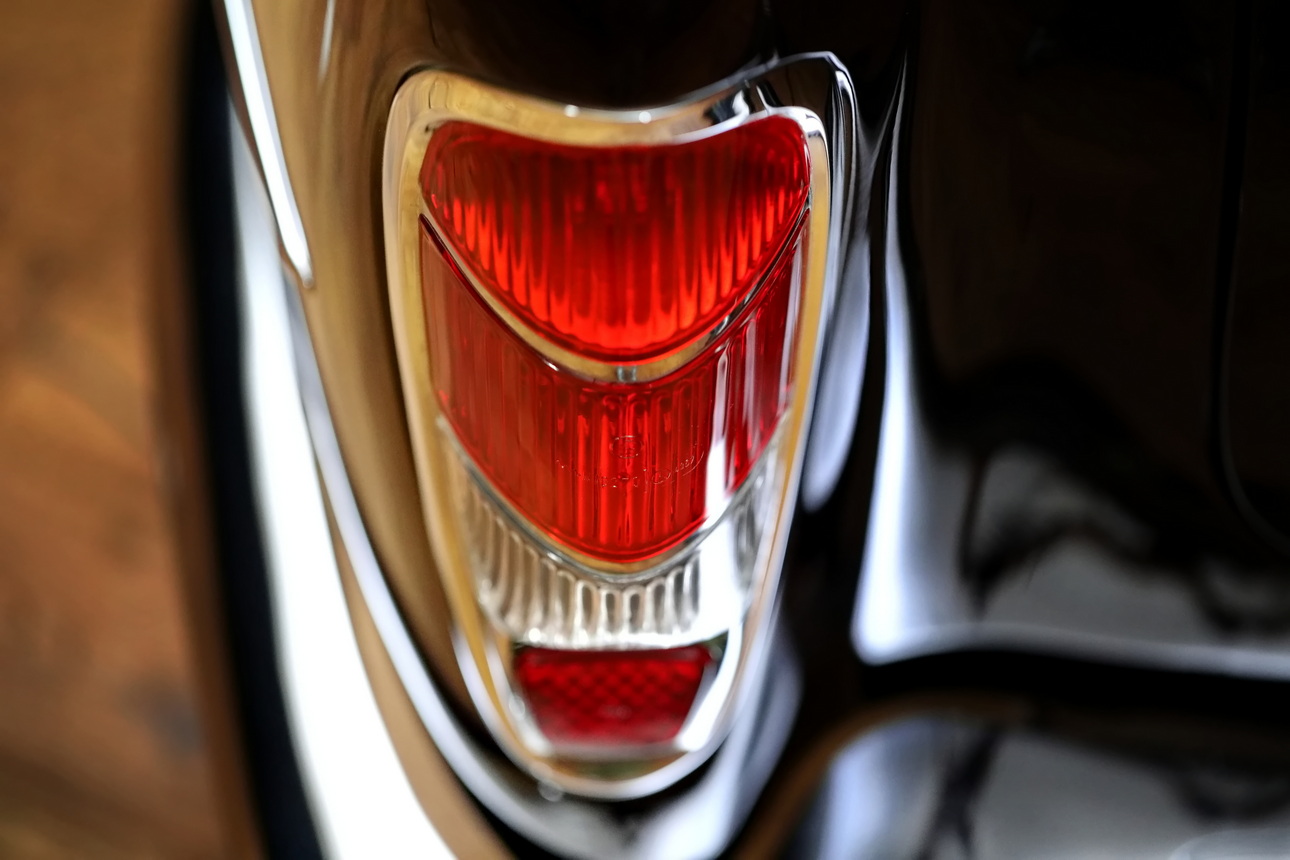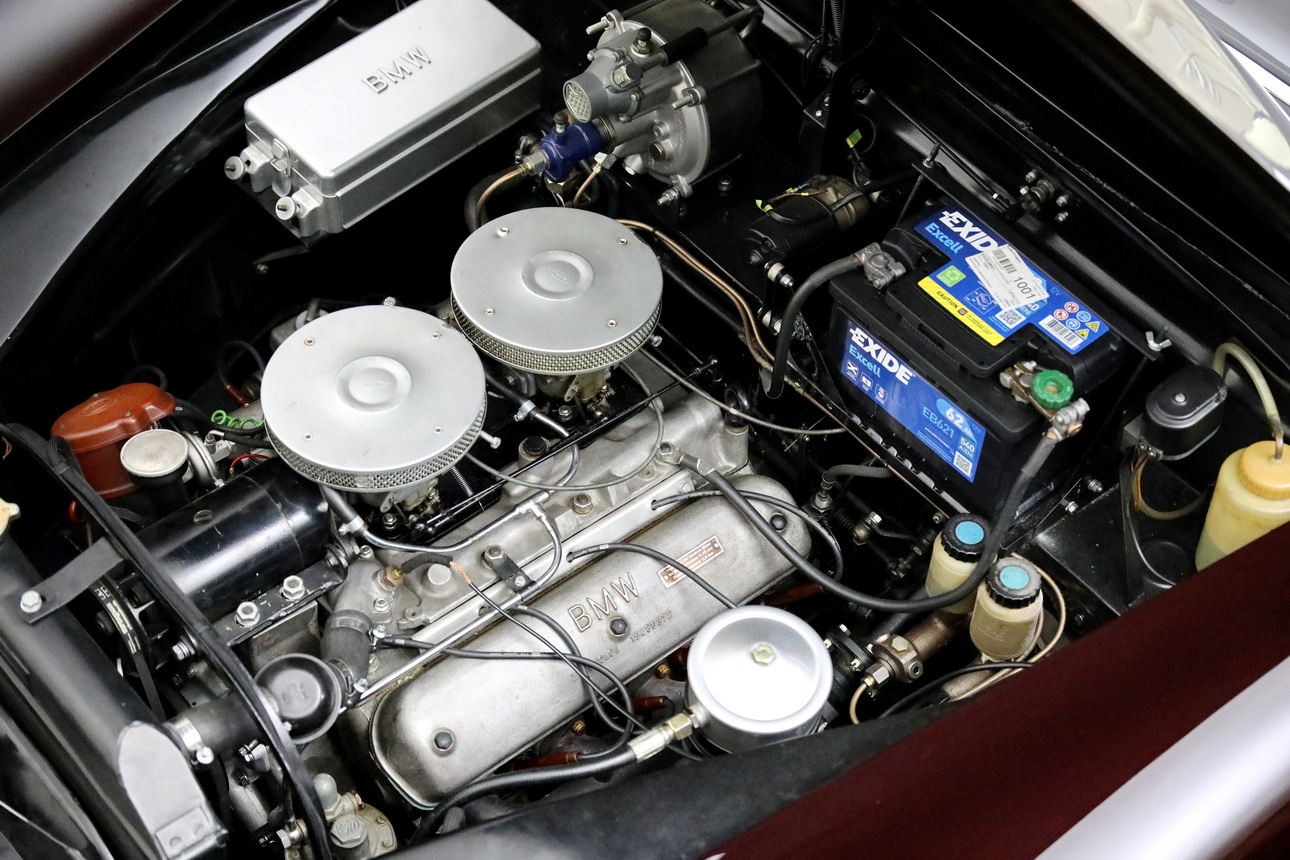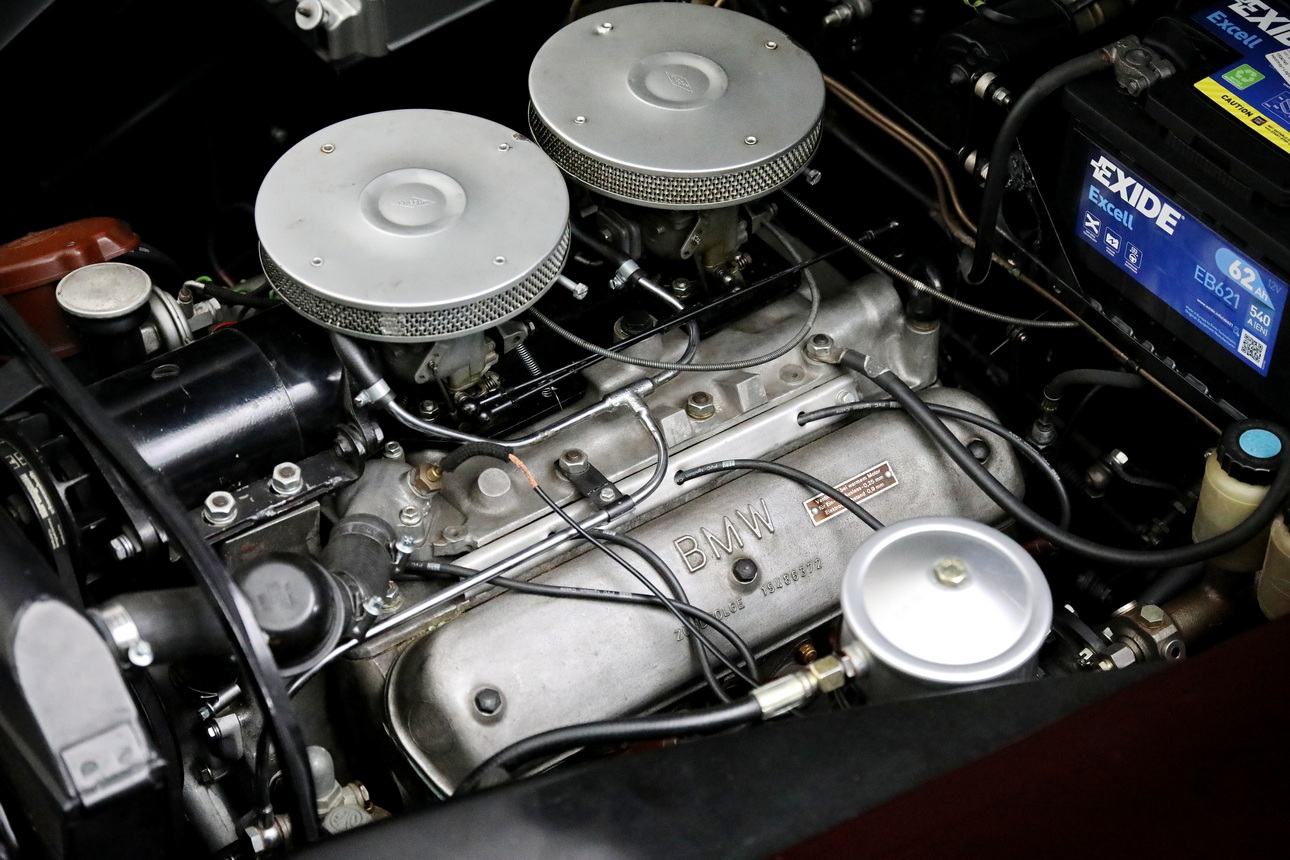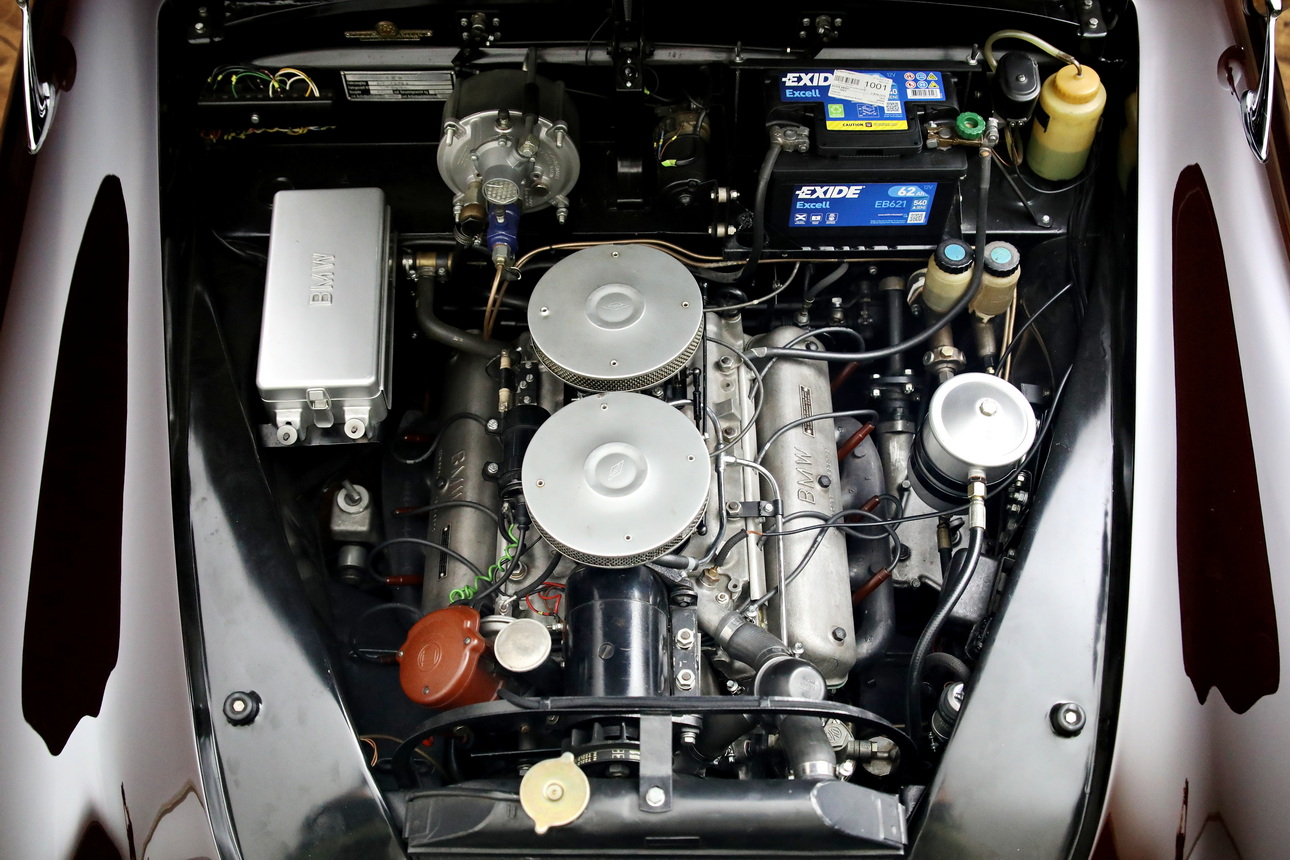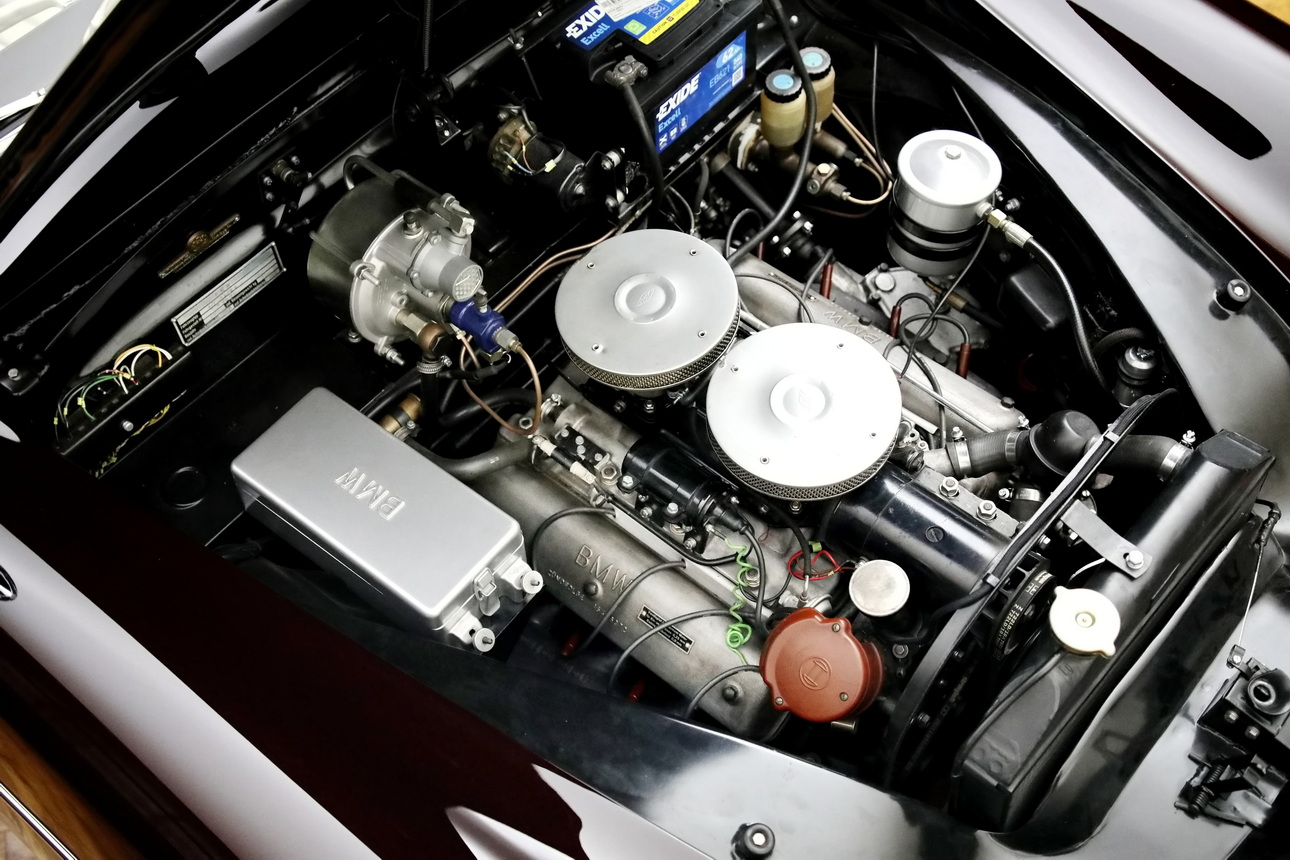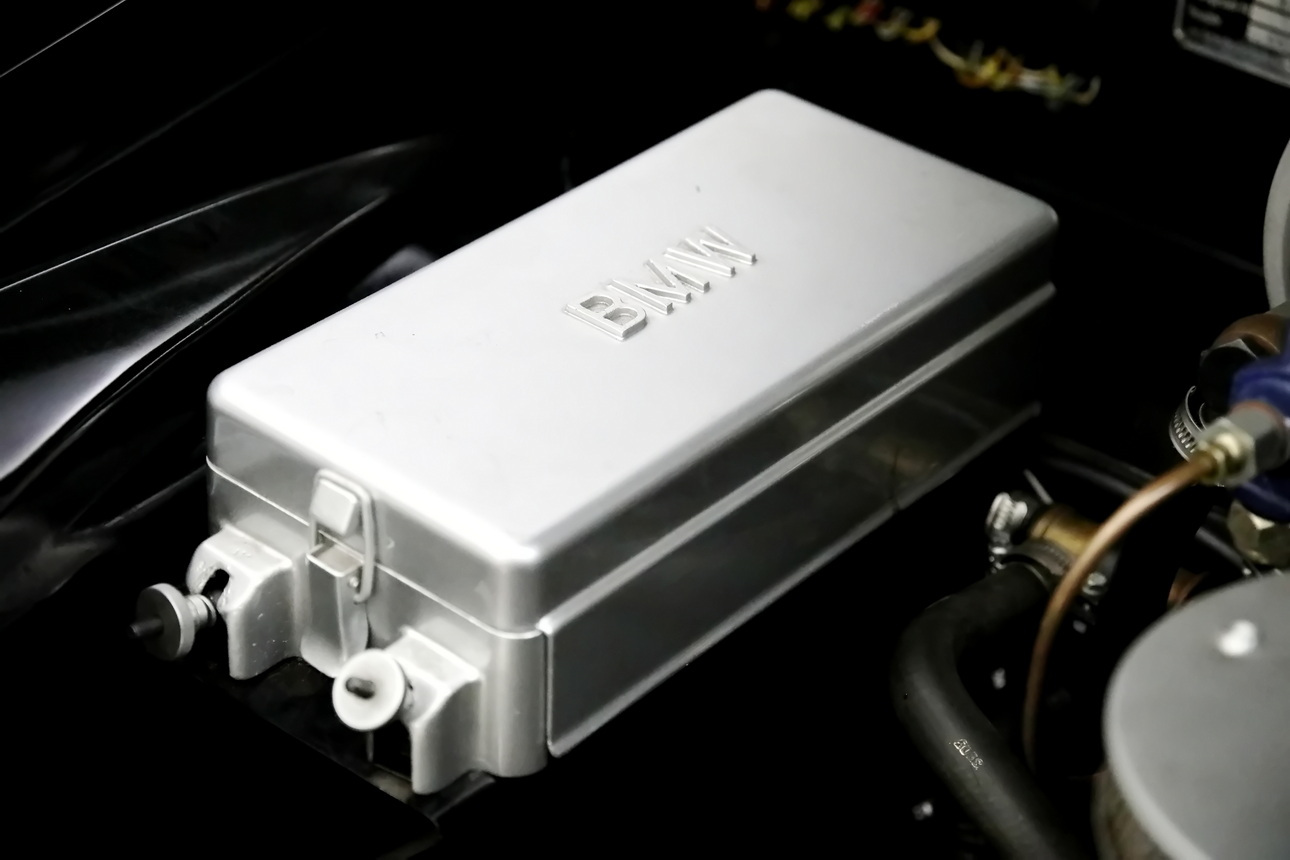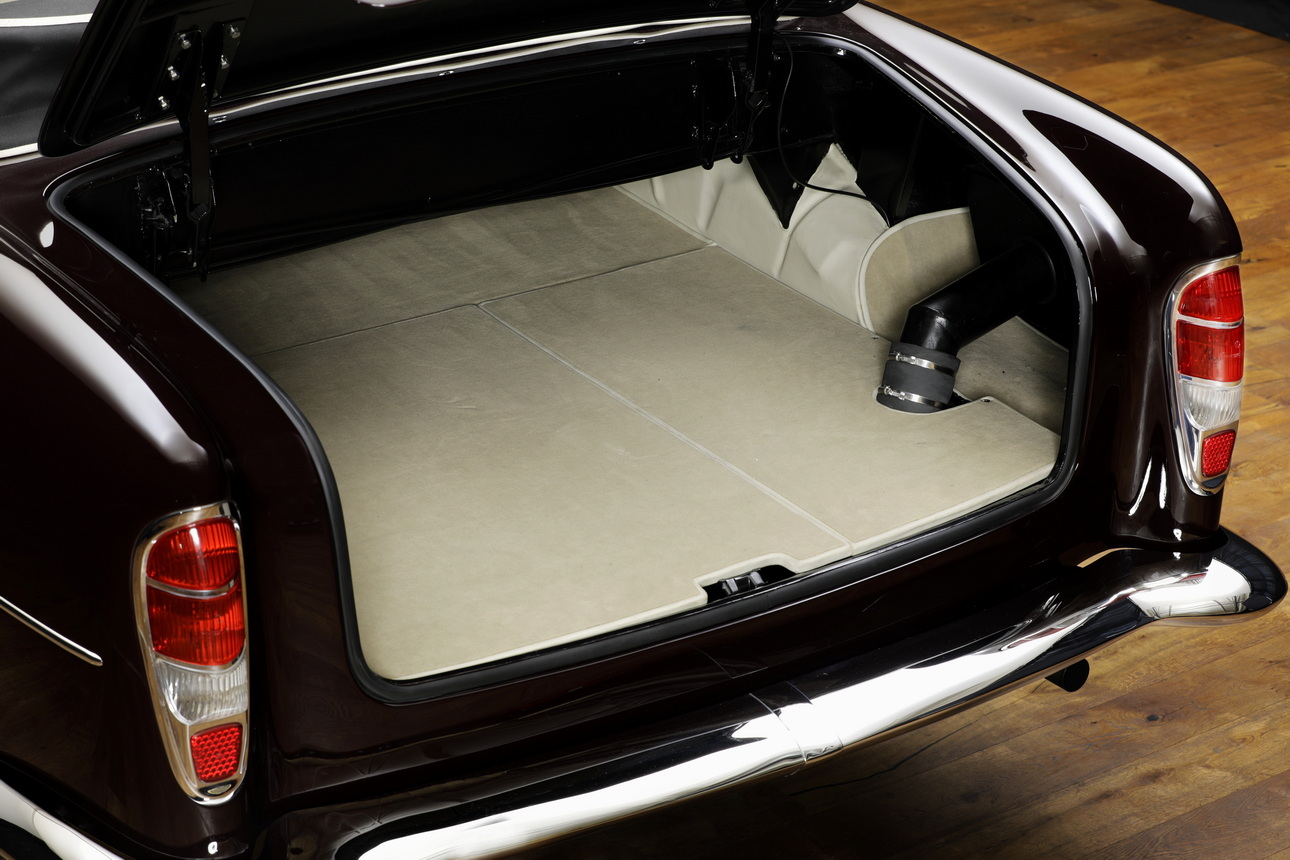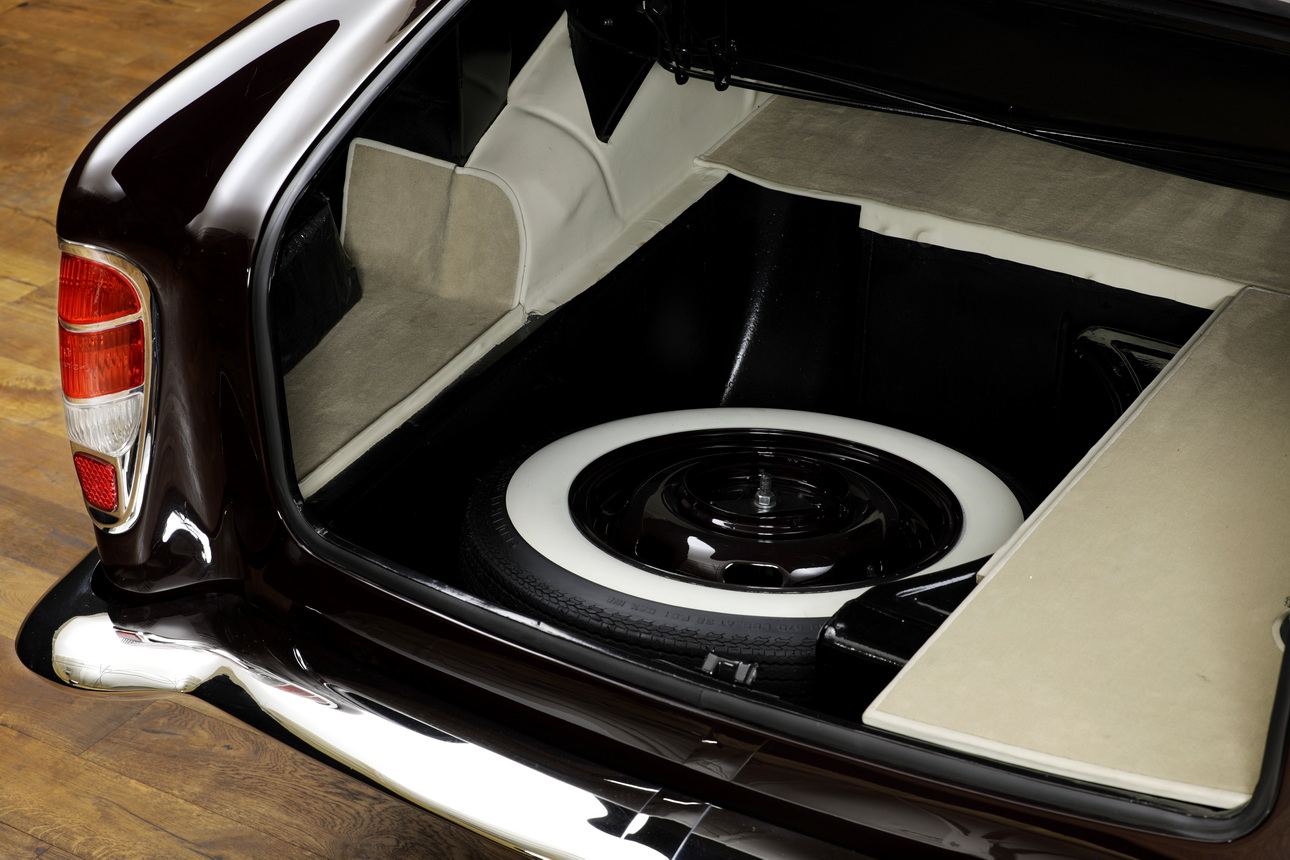BMW 502 3.2 ‚Super‘ Cabriolet by Autenrieth
Highlights
Data & Facts
This Automobile
This BMW is absolutely unique. A four-door convertible body was created for a BMW 502 Rolling Chassis with a 3.2 litre V8 engine from in 1960. It was built by the coachbuilder Autenrieth in Darmstadt and commissioned by the Hamburg lawyer Walter Hoepffner. According to the original vehicle registration document, the car was first registered to him on 25 February 1960. With a price of more than 31,000 Deutschmarks, the tailor-made BMW was in the price range of the BMW 507 and Mercedes-Benz 300 SL at the time.
The clean and modern design conceals a high degree of elegance – the famous love that only unfolds at second glance. Its paintwork in the colour “dark red-brown” develops a deep, dark red shine and high luminosity, especially in sunlight. The paint finish is absolutely smooth and even the chrome trim sparkles like on the first day. The bodywork is of high quality as well. All side panels have excellent flatness, the gaps and fits are excellent. The low window system with frameless side windows and the flat soft top give this one-off an almost sporty touch. The dashboard made of light-coloured wood and with silver-grey instruments was individually manufactured and differs from the 502 series of the time.
According to the original vehicle registration document, the car was registered after one year to a family member of the first owner, who kept the special BMW until the summer of 1966. The car then remained in Hamburg and passed into the hands of a car technician (name known). In 1968, the Autenrieth Cabriolet came to a young automobile historian (name known), who was fascinated by the unique example.
The car was later owned by a tax consultant along with other classic cars and was purchased by a well-known classic car collector and dealer in Austria in 2004. A comprehensive restoration over four years to new condition followed. Subsequently, a FIVA passport and an individual approval certificate for Austria were issued in 2009. A few years later (2015/2016), the BMW entered the collection of a logistics and transport entrepreneur, also in Austria. He was invited to present the Autenrieth Cabriolet at the famous Pebble Beach Concours d'Elegance in 2016 – as part of a ‘special delegation’ to celebrate the 100th anniversary of the BMW brand. A privileged honour and proof of the special status of this unique automobile.
The engine is of course the original unit and the V8 technology with 140 hp promises sufficient power and performance in every driving situation. Thanks to its generous amount of space, it is easy to imagine travelling with the family to far-flung destinations in this car. The Autenrieth Cabriolet would also be a potential winner at any Concours d'Elegance. A customised bodywork of this beauty is simply extraordinary.
Model History
The BMW 501/502 series were four-door luxury-class saloons that were built from 1952 to 1964. The Type 501 was the first BMW model made in Munich; all previous models came from the factory in Eisenach. It was powered by a six-cylinder in-line engine with a displacement of 2 litres and an output of 65 hp. Because of their curved lines, they were also known as ‘Baroque Angels’. The body design came from Peter Szymanowski, the former plant director of the BMW factory in Eisenach.
In 1954, BMW presented the 502 at the Geneva Motor Show. Visually in the same body as the 501, the engine was a sensation: the first newly designed eight-cylinder engine in Germany after the Second World War. The V8 had a displacement of 2.6 litres and 100 hp. A year later, a version with a 3.2-litre displacement and 120 hp was presented at the IAA in Frankfurt. Its output increased to 140 hp in 1957 and the model was given the suffix ‘Super’. From 1959, front disc brakes and brake servo were standard on this version. The output of the 3.2-litre V8 was increased to 160 hp in the BMW 3200 S in 1961. All vehicles had rear-wheel drive and a fully synchronised four-speed gearbox with steering wheel gearstick. In 1963, the chassis was modernised with stabilisers at the front and Panhard bars at the rear. In addition, production was switched to flange-mounted gearboxes with centre shift. During the twelve-year production period, 23,000 vehicles were manufactured. This figure includes around 280 cabriolets and coupés with bodies from Baur in Stuttgart and Autenrieth in Darmstadt.
Coach builder Autenrieth: The Autenrieth coachbuilding company was founded in 1918 by the wheelwright Georg Autenrieth in Weinsberg near Heilbronn. Its first customers were NSU and Daimler. In 1922, the company moved to Darmstadt and traded under the name ‘Erste Darmstädter Karosseriewerke Georg Autenrieth’. The company manufactured saloons, coupés and cabriolets on the chassis of various pre-war car manufacturers such as Adler, Audi, BMW, Horch, Maybach, Mercedes Benz, Opel and NSU to individual customer specifications. In addition, some cabriolets were built on the basis of the KdF car, the later VW Beetle.
During the Second World War, car body production had to be discontinued and the company became an armaments supplier. During the reconstruction phase after the war, the co-operation with BMW was resumed. The vehicles with bodies that were not yet self-supporting were still suitable for third-party bodywork. Hence, in the 1950s coupés and convertibles based on the BMW 501/502 series were created in considerable numbers, including various special one-offs.
This Automobile
This BMW is absolutely unique. A four-door convertible body was created for a BMW 502 Rolling Chassis with a 3.2 litre V8 engine from in 1960. It was built by the coachbuilder Autenrieth in Darmstadt and commissioned by the Hamburg lawyer Walter Hoepffner. According to the original vehicle registration document, the car was first registered to him on 25 February 1960. With a price of more than 31,000 Deutschmarks, the tailor-made BMW was in the price range of the BMW 507 and Mercedes-Benz 300 SL at the time.
The clean and modern design conceals a high degree of elegance – the famous love that only unfolds at second glance. Its paintwork in the colour “dark red-brown” develops a deep, dark red shine and high luminosity, especially in sunlight. The paint finish is absolutely smooth and even the chrome trim sparkles like on the first day. The bodywork is of high quality as well. All side panels have excellent flatness, the gaps and fits are excellent. The low window system with frameless side windows and the flat soft top give this one-off an almost sporty touch. The dashboard made of light-coloured wood and with silver-grey instruments was individually manufactured and differs from the 502 series of the time.
According to the original vehicle registration document, the car was registered after one year to a family member of the first owner, who kept the special BMW until the summer of 1966. The car then remained in Hamburg and passed into the hands of a car technician (name known). In 1968, the Autenrieth Cabriolet came to a young automobile historian (name known), who was fascinated by the unique example.
The car was later owned by a tax consultant along with other classic cars and was purchased by a well-known classic car collector and dealer in Austria in 2004. A comprehensive restoration over four years to new condition followed. Subsequently, a FIVA passport and an individual approval certificate for Austria were issued in 2009. A few years later (2015/2016), the BMW entered the collection of a logistics and transport entrepreneur, also in Austria. He was invited to present the Autenrieth Cabriolet at the famous Pebble Beach Concours d'Elegance in 2016 – as part of a ‘special delegation’ to celebrate the 100th anniversary of the BMW brand. A privileged honour and proof of the special status of this unique automobile.
The engine is of course the original unit and the V8 technology with 140 hp promises sufficient power and performance in every driving situation. Thanks to its generous amount of space, it is easy to imagine travelling with the family to far-flung destinations in this car. The Autenrieth Cabriolet would also be a potential winner at any Concours d'Elegance. A customised bodywork of this beauty is simply extraordinary.
Model History
The BMW 501/502 series were four-door luxury-class saloons that were built from 1952 to 1964. The Type 501 was the first BMW model made in Munich; all previous models came from the factory in Eisenach. It was powered by a six-cylinder in-line engine with a displacement of 2 litres and an output of 65 hp. Because of their curved lines, they were also known as ‘Baroque Angels’. The body design came from Peter Szymanowski, the former plant director of the BMW factory in Eisenach.
In 1954, BMW presented the 502 at the Geneva Motor Show. Visually in the same body as the 501, the engine was a sensation: the first newly designed eight-cylinder engine in Germany after the Second World War. The V8 had a displacement of 2.6 litres and 100 hp. A year later, a version with a 3.2-litre displacement and 120 hp was presented at the IAA in Frankfurt. Its output increased to 140 hp in 1957 and the model was given the suffix ‘Super’. From 1959, front disc brakes and brake servo were standard on this version. The output of the 3.2-litre V8 was increased to 160 hp in the BMW 3200 S in 1961. All vehicles had rear-wheel drive and a fully synchronised four-speed gearbox with steering wheel gearstick. In 1963, the chassis was modernised with stabilisers at the front and Panhard bars at the rear. In addition, production was switched to flange-mounted gearboxes with centre shift. During the twelve-year production period, 23,000 vehicles were manufactured. This figure includes around 280 cabriolets and coupés with bodies from Baur in Stuttgart and Autenrieth in Darmstadt.
Coach builder Autenrieth: The Autenrieth coachbuilding company was founded in 1918 by the wheelwright Georg Autenrieth in Weinsberg near Heilbronn. Its first customers were NSU and Daimler. In 1922, the company moved to Darmstadt and traded under the name ‘Erste Darmstädter Karosseriewerke Georg Autenrieth’. The company manufactured saloons, coupés and cabriolets on the chassis of various pre-war car manufacturers such as Adler, Audi, BMW, Horch, Maybach, Mercedes Benz, Opel and NSU to individual customer specifications. In addition, some cabriolets were built on the basis of the KdF car, the later VW Beetle.
During the Second World War, car body production had to be discontinued and the company became an armaments supplier. During the reconstruction phase after the war, the co-operation with BMW was resumed. The vehicles with bodies that were not yet self-supporting were still suitable for third-party bodywork. Hence, in the 1950s coupés and convertibles based on the BMW 501/502 series were created in considerable numbers, including various special one-offs.
